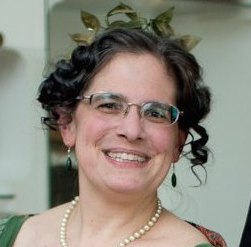The Polka Dot Waltz was either a sequence dance or waltz variant described by Melvin B. Gilbert in Round Dancing (Portland, Maine, 1890) and later by [George] Washington Lopp in his translation-plus of Gilbert’s book, La Danse (Paris, 1903), in which it is listed as Polka Dot (Valse). Both Gilbert and Lopp credit it to Herman Strassburg, presumably the same dancing master who was the author of the Call Book of Modern Quadrilles (Detroit, 1889).
The pattern of the Polka Dot, its imaginative name, and the way Lopp formats the title make me suspect that this was not a variation for normal waltzing but instead was intended as a choreographed sequence dance matched to a particular piece of music. I’ve only been able to find one piece of sheet music by that title, “The Polka Dot Waltz”, by Edward A. Abell, (San Francisco, 1873), which is archived on the Library of Congress website. It does not include dance instructions. It is possible that Strassburg wrote this as choreography to go with it, or with a different waltz by the same name, but in the absence of proof one way or the other, it is also possible to dance it to any waltz music with even eight-bar phrases, either by the entire room dancing it in unison or by individual couples using it (carefully!) as a variation.
The Polka Dot sequence consists of two parts. First is a two-bar hesitation followed by a two-bar “Metropole” slide/waltz combination, all of which is repeated, for a total of eight bars. The second part consists simply of eight bars of waltz. This is a classic sequence dance pattern: do something, repeat it the other way or on the other foot, then do eight measures of a turning dance. In many sequence dances, the repeat is against the line of dance, which makes them extremely unsuitable for use by individual couples in the midst of a regular waltz. Since in the Polka Dot the sequence includes only a hesitation in place, it is workable in normal dancing if the dancers are careful. Since stopping dead in place for two measures at a time will cause problems for dancers behind them, moving to the center or otherwise out of the main flow of the dance before beginning the Polka Dot would be both smart and polite.
The complete sequence for the Polka Dot is given below, with steps for the gentleman. The lady dances opposite. The couple begins with the gentleman facing the wall and the lady the center of the room.
1b Bend right knee and extend left foot to second position
1b Bring left foot back to fifth position behind and bend right knee
1b Slide left foot to the side, bending both knees (12), and close right (3)
1b Waltz, starting left foot backward along line of dance
4b Repeat all of the above, starting on the opposite foot
8b Waltz
Note that the gentleman’s weight remains on the right foot throughout measures one and two. (The lady’s remains on her left.) It’s awkward to draw one foot back from second to fifth while keeping the other knee bent, and it looks and feels ridiculous to keep the knees bent for three measures in a row, so I would bob up and down twice during bars one through three and five through seven of the sequence, bending on the first beat and rising on the third beat of each measure. This is more graceful in practice than it sounds; the first two bars look and feel like abbreviated courtesies.
The waltz used would be the “new waltz” of the later nineteenth century. It’s not clear whether Gilbert want the all-out “leap-slide-cut” version or the gliding “step-slide-close” version. Lopp’s later description specifies a “boston” step, which glides rather than leaps. I would favor the gliding version for the single bar of waltz on bars four and eight, and for the final eight bars if the room is dancing in unison. A couple dancing it individually could dance it in a more Gilbert-style way with leaps and cuts on the final eight bars.
Note that on the third and seventh measures (the slide/close), the dancers need to make a quarter-turn clockwise so they are in position to make a clean step forward or backward along the line of dance when initiating the waltz on the fourth and eighth measures. Likewise, at the end of the waltz on the fourth bar and at the end of the eight bars of waltzing at the end, the dancers need to underturn slightly to end with the gentleman facing the wall.
It is possible to turn in reverse on bars four and eight and during all or part of the final eight bars of waltz. During the latter one could also mix in simple “pursuit” (forward or backward) waltzing. But if the entire room is dancing this as a sequence dance, I would suggest sticking to the standard natural turn throughout.
It is also possible to break out the pieces of the Polka Dot and use the two-bar hesitation, the slide, and the waltz separately in different combinations. Once again, dancers should be extremely careful about using the hesitation because of its potential to block other dancers’ paths.


Leave a Reply